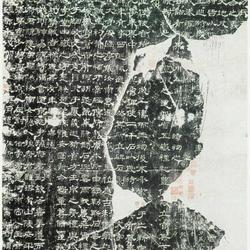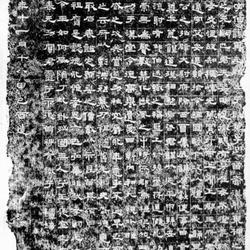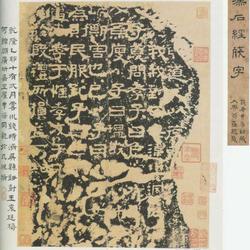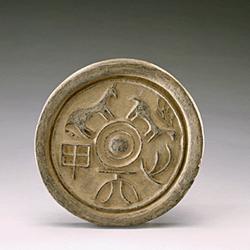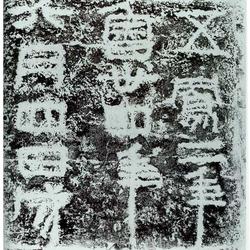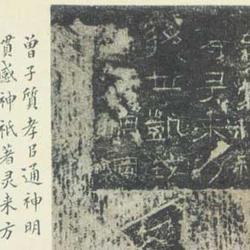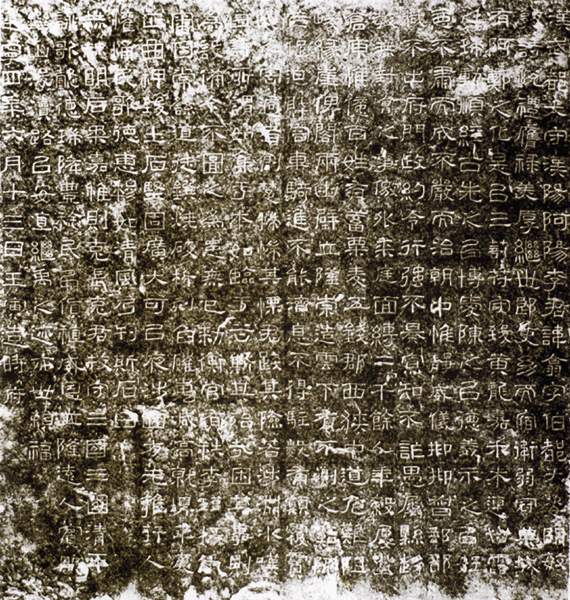
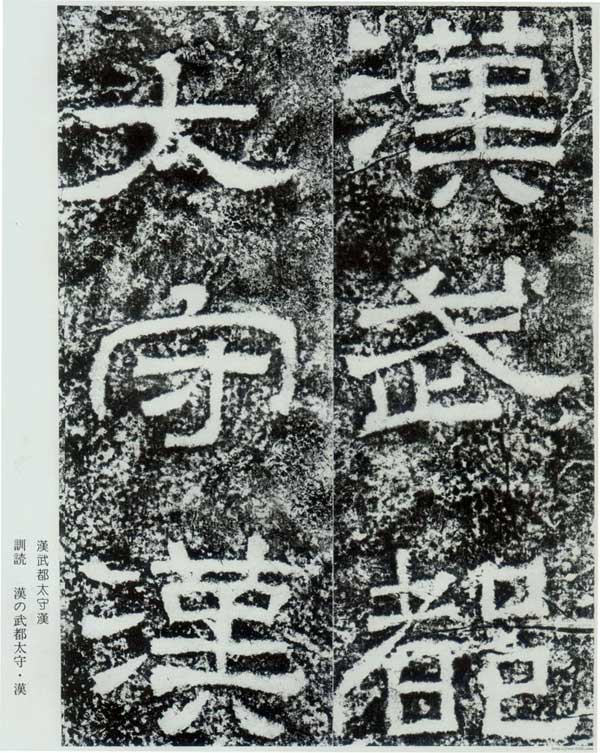
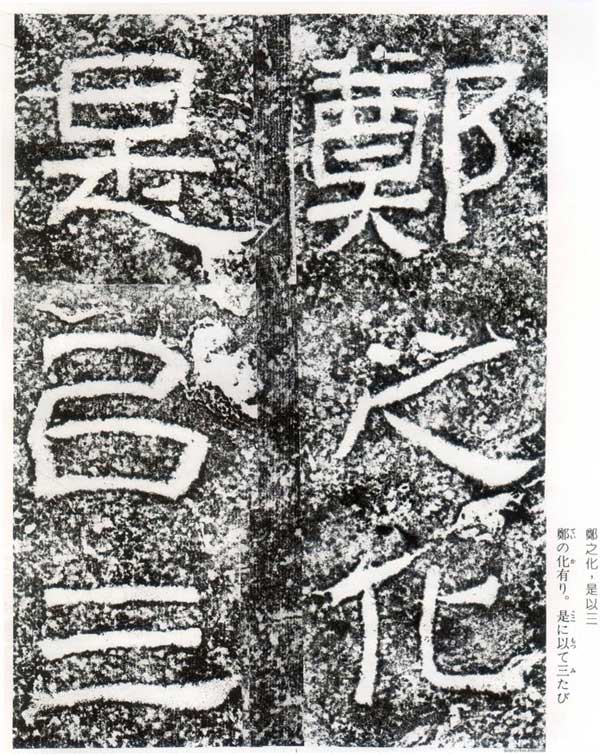
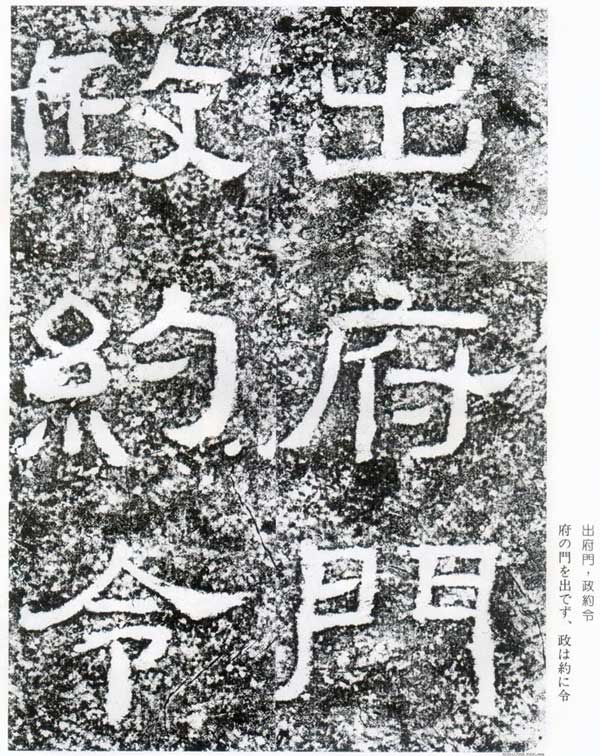
Cliff carved stone, Han Dynasty official script. The full name is "Hanyang Heyang Li Xixiao Ode to the West of the Han Dynasty Governor". There are four seal characters "Hui'an Xibiao" on the forehead, so it is also called "Hui'an Xibiao", also known as "Li Xi Stele", "Li Xi Ode", and is commonly known as "Huanglong" monument". It was engraved on June 13, the fourth year of Jianning (AD 171) by Emperor Ling of the Eastern Han Dynasty (Liu Hong), at Qinglongtou in the middle section of the west narrow section of Chengxian County, Gansu Province. The characters on this stone are ancient, solemn and majestic. The pen is simple and thick, both square and round, and the pen is powerful. Yang Shoujing commented: "It is square and majestic, with no defects at the beginning or end, which makes it especially valuable." At the end of the inscription, the two characters "Qiu Jing" are engraved, which is the first example of a calligrapher's inscription.
"Ode to the West" The cliff can be divided into four parts.
(1) The main text is a standard square, 145 centimeters vertically and horizontally, 20 lines, 20 characters per line, totaling 385 words. The main text mainly describes the origin and family background of Li Xi, the prefect of Wudu, and the benefits of the construction of Xizhage Road to the people. political achievements. (2) On the seal forehead of "Ode to the West", there is a row of four small seal characters "Hui'an Xibiao" on the top. The diameter of the characters is about 13 cm long and 9 cm wide. (3) The title at the end of the article, 12 lines, 114 words, is smaller than the main text, and the font is slightly flat. The tenth line: "Distinguish the Chinese and German calligraphy of Qiu Jing from the historical position". It can be seen that "Ode to the West" "Hui Han's words" They are all Si people" ("Li Xu" by Hong Shi of the Southern Song Dynasty). (4) "Five Auspicious Pictures", located at the corner in front of the main text, are engraved with 6 images of "Yellow Dragon", "White Deer", "Mu Lianli", "Jiahe", "Ganlu Falling" and "Dew Bearer". and the corresponding question list in 6 places and 15 words. Between the "Five Auspicious Pictures" and the main text, there are two lines of inscriptions with 26 words: "In the past, when you were in Lianchi, you were managing the way of Xiaocai. You were proficient in the rule of virtue and achieved the auspiciousness of yellow dragons and white deers, so you painted their images." In addition, under the picture of "Mu Lianli", there are 4 lines of small print and 34 words of the title (7 characters): "The five sense organs are on the road, Shangguan Zhengzi is selected by the emperor/□□□□Shanglu Yang Si is named Wenming/□□□掾下Identify Li Jing's character Changdu/ji (the character 'ji' is larger and was added by later generations)."
"Ode to the West" is an outstanding cliff monument in the Eastern Han Dynasty of my country. It has a beautiful style and wonderful words. It integrates seal script, main text, title, inscription and engraving. His ancient calligraphy art and grand, simple and vigorous Han painting style have been highly praised by calligraphers and painters at home and abroad. Fang Shuo's "Inscriptions and Postscripts on the Paintings and Calligraphy of Zhenjing Hall" of the Qing Dynasty praised it as "broad and profound"; Kang Youwei's "Guang Yizhou Double Collection" praised it as "sparse"; Yang Shoujing's "Commentary on the Stele" praised it as "straight and majestic, with no beginning or end". "One thing is missing"; Xu Shujun's "Bao Ya Zhai Inscription and Postscript" lamented that he was "dispersed and elegant, like the wind blowing the fairy's sleeves floating in the clouds. Those who explore unusual paths are very interesting among Han Li"; Liang Qichao's "Stele Inscriptions and Postscript" praises him : "Majestic and quiet, the Han Dynasty is the rule"; the famous Japanese calligrapher Ushimaru Yoshinoichi believes: ""Ode to the West" is the highest masterpiece of Moya in the Han Dynasty."
Explanation: Hui Anxi Biao, the prefect of Wudu of Han Dynasty, Hanyang Ayang, Li Juntaixi, named Bodu. The nature is bright and intelligent, Dun's "Poetry" is pleasing to "Li", he has a good fortune and a good salary, and he has succeeded to the throne. He is young and lives in the guard, and he is weak in the crown city. "With the transformation of Azheng, it is guarded by three [bamboo/cut] talismans, which bring about the auspiciousness of Huanglong, Jiahe, Mulian and Ganlu. "According to the ancient scriptures, the first is fraternity, the second is virtue and righteousness, and the second is good and evil. The court is quiet and majestic. He is responsible for supervising the Postal Department. He does not leave the house, carries out political orders and orders, does not bully the weak when he is strong, and does not cheat or fool. It belongs to the county trend religion and has nothing to do with the meeting. When he came to the court, more than two thousand people were bound in front of him. The crops have been harvested many times every year, and the warehouses and warehouses are only 100 million, and the people have savings, including five qian for millet and wheat. The narrow middle road in the west of the county is dangerous and steep. It is surrounded by cliffs and pavilions. There are two mountains standing on the wall. There are lofty and high clouds. There is an unexpected stream at the bottom, and the disaster is rushing. Wealthy chariots and riders cannot advance, and cannot stop. There are several dangers of overturning tunnels. Those who pass by will create Chu, and they will be anxious. You practice the danger as if you were wading into the deep water. "Sigh," he said, as the poem says: "It's like gathering trees, it's like being in a valley." It's very dangerous. If you are trapped in something, it's equipment. If you don't plan for it now, you will be in trouble. Li Jin, the official of the imperial edict, had a rank, and he tried to punish the enemy. Because Chang Yao {繇, today's character} was Taoist, he burned it and analyzed it, carved Cui Wei {falling, today's character}, reduced the height to Pi, and leveled the land. , Zhenzhi earth and stone. It is strong and broad and can be forded at night. There is no peace in all directions, and travelers are delighted. Folk songs are virtuous, and music is like the breeze. Nai published this stone and said: "
After He Heming, Rou Jiawei followed. To defeat the leader and conquer the king, to protect the three kingdoms. "Three Kingdoms are peaceful and peaceful," chanting Yide. When auspiciousness descends, the people are rewarded with goods. With grace and grace, people from afar are impressed. "The mountains are dredged and the roads are straightened. Following Yu's legacy, he will also be blessed in the world. "On June 13th, the fourth year of Jianning, Renyin built the palace. "
Cheng You Fufeng Chencang Lu Guozi Wenbao. "The disciples at the door identified Li Wen as Zixing. Therefore, I was engaged in a discussion with Cao Cao about Li Min's courtesy name Zhongqi. Therefore, under the master's book, Li Sui's courtesy name is Zihua. Therefore, the main register of "Lu Shixiang" has the character Yuan Qi. "The facial features are high, Zhang Kang's courtesy name is Uncle Hui. Therefore, he worked as a meritorious officer and identified the Yuan heir of Jiang Na. The reason is "Wei Cao Shi Wudu Wang Ni" named Kong Guang. ” Hengguan Youzhi distinguishes Li Jin’s courtesy name Weifu. "Distinguish Qiu Jing's character Han De and calligraphy from the historical position. "Xiabiao Daochang Guanghan Zhifangren's poems and characters started at a young age. "Xia Bian Cheng An Dingchao that Huangfu Yan Zicai. "

